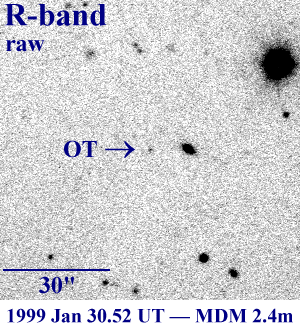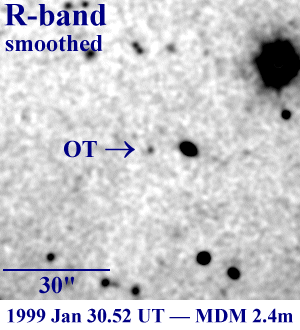I. A. Yadigaroglu, J. P. Halpern, R. Uglesich, & J. Kemp (Columbia U.)
report on behalf of the MDM Observatory GRB follow-up team:
"We imaged the field of GRB 990123 in the R band on Jan. 30.52 using the
MDM Observatory 2.4m telescope. A total of 40 minutes exposure was
obtained in seeing of 0.9-1.0 arcsec. The optical transient is clearly
detected at magnitude R = 23.01 +/- 0.24 (referenced to the comparison
star of GCN #207, assuming r - R = 0.4). An independent calibration
using a Landolt standard also gives a consistent magnitude. The OT
position, measured with respect to the USNO-A2.0 reference system,
is (J2000) RA 15:25:30.34, Dec +44:45:59.2 with an uncertainty of
0.3 arcseconds in radius. This position is consistent with that of the
original detection of the OT (GCN #206). The temporal power-law decay
slope connecting our observation to the first Palomar detection is
alpha_r = -1.15 +/- 0.07, consistent with all previous observations,
which gave alpha_r = -1.13 +/- 0.03 (GCN #240).
Thus, the OT appears to be unresolved, at a fixed position, and following
a power-law decay in time.
However, we see no object corresponding to a suggested intervening
galaxy that was estimated to lie 1.8 arcsec north of the OT (GCN #206).
In fact, there is no other object on our image within 5 arcsec of the
OT, to a limiting magnitude of approximately R = 24. Since this galaxy
was only reported to be seen marginally on one POSS II red plate with
R = 21.5 +/- 0.5 (GCN #213), we conclude that it probably does not
exist. If true, this eliminates one of the arguments for hypothesizing
that the burst is lensed."
This message may be cited.
|


